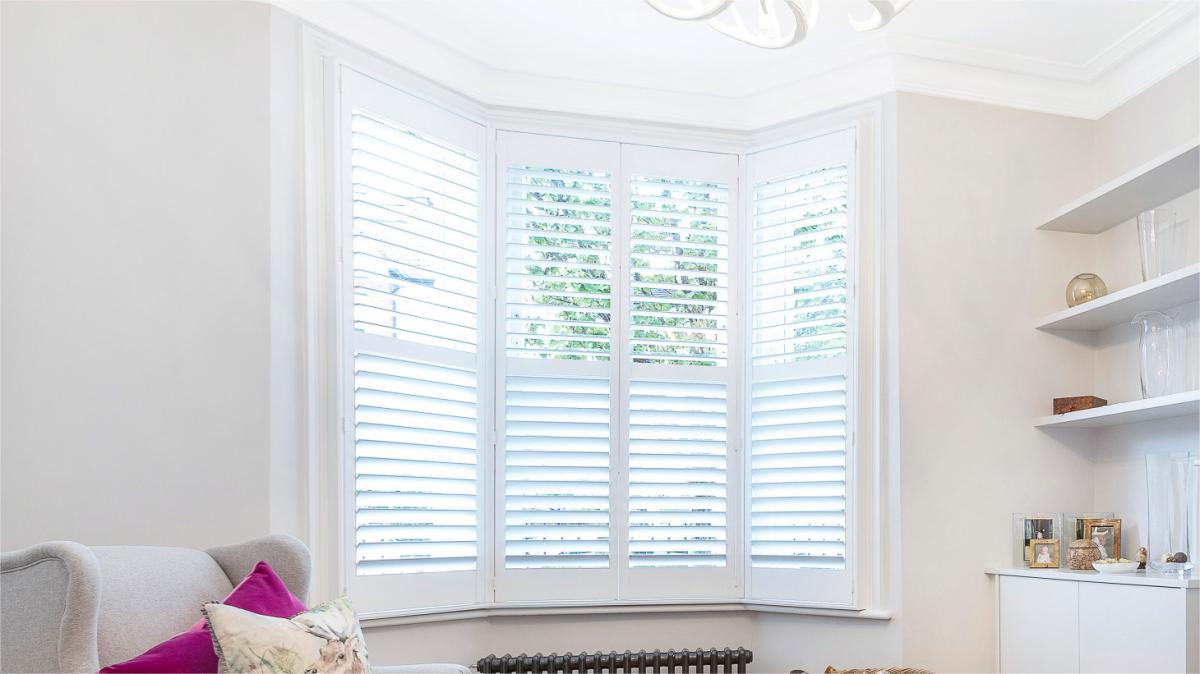A bay window is a type of window that extends outward from the wall, creating a triangular or rectangular space that can be used for various purposes. Bay windows are often found in older homes but can be added to new or renovated ones. Bay windows are popular architectural features because they offer many benefits, such as enhancing natural light, creating cozy nooks, and adding value to the property.
If you have a bay window in your home, you might wonder what window treatment is best suited. Many options are available, such as plantation shutters, blinds, and curtains. Each option has pros and cons, depending on budget, preference, style, and functionality. This article will compare and contrast three different window treatments for bay windows: plantation shutters, blinds, and curtains. We will discuss their main features, advantages, and disadvantages, as well as tips on choosing the best one for your bay window.
Plantation Shutters for Bay Windows
Plantation shutters, with their timeless charm and versatility, emerge as an excellent choice for bay windows. Let’s explore the advantages, aesthetic appeal, customization options, and practical considerations of incorporating plantation shutters into your bay window design.
Advantages and Aesthetic Appeal
Timeless Elegance: Plantation shutters exude a timeless elegance that complements the classic architecture of bay windows. The clean lines and wide louvers contribute to a sophisticated and refined look.
Versatile Design: The versatile design of plantation shutters allows for precise control over light and privacy. Louvers can be adjusted to capture the desired natural light while maintaining privacy.
Durability and Longevity: Crafted from durable materials such as wood, composite, or vinyl, plantation shutters are built to last. Their robust construction withstands the test of time, making them a durable and worthwhile investment.
Increased Home Value: The aesthetic appeal and functional benefits of plantation shutters can enhance the overall value of your home, making them an attractive feature for potential buyers.

Customization Options for Plantation Shutters
Materials and Finishes: Customize your plantation shutters with a choice of materials, including hardwoods like basswood or composite options. Explore different finishes to achieve the desired aesthetic, from natural wood tones to contemporary painted finishes.
Color Choices: Plantation shutters offer a wide range of color choices, allowing you to match or contrast with your interior color scheme. Classic whites, bold colors, or natural wood tones provide versatile options.
Practical Considerations and Functionality
Light Control and Privacy: Plantation shutters provide exceptional control over light and privacy. The adjustable louvers enable you to regulate the amount of sunlight entering the room while maintaining a comfortable level of privacy.
Ventilation and Airflow: The ability to adjust louvers allows for effective ventilation, promoting airflow in the room. This is particularly beneficial in maximizing the advantages of bay windows for fresh air circulation.
Easy Maintenance: Plantation shutters are relatively easy to maintain. Regular dusting and occasional cleaning with a mild solution keep them looking pristine. The durability of materials ensures they withstand the demands of daily use.
Insulation Properties: The structure of plantation shutters contributes to insulation, helping regulate indoor temperatures. This insulation factor can benefit energy efficiency and create a comfortable living environment.

Window Blinds for Bay Windows
Window blinds offer a versatile and modern window covering solution, and they can be particularly well-suited for bay windows. In this section, we’ll explore the different types of blinds, their light control and privacy features, and the design flexibility and material options available for bay windows.
Different Types of Blinds Suitable for Bay Windows
Vertical Blinds: Ideal for bay windows with a larger expanse, vertical blinds have slats that run vertically. They can be easily adjusted to control light and offer a contemporary look.
Venetian Blinds: Venetian blinds are a classic choice featuring horizontal slats that can be tilted for light control. They come in various materials, including wood, aluminum, or faux wood, providing design flexibility.
Roman Blinds: their elegant fabric panels add a soft and luxurious touch to bay windows. They can be raised or lowered to control light, offering a timeless and sophisticated look.
Roller Blinds: Roller blinds consist of a single piece of fabric that can be rolled up or down. They are sleek and simple and come in various textures and patterns, making them suitable for different interior styles.

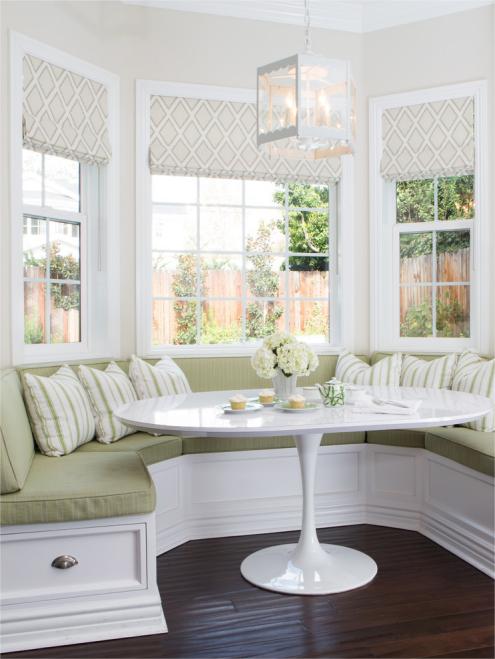
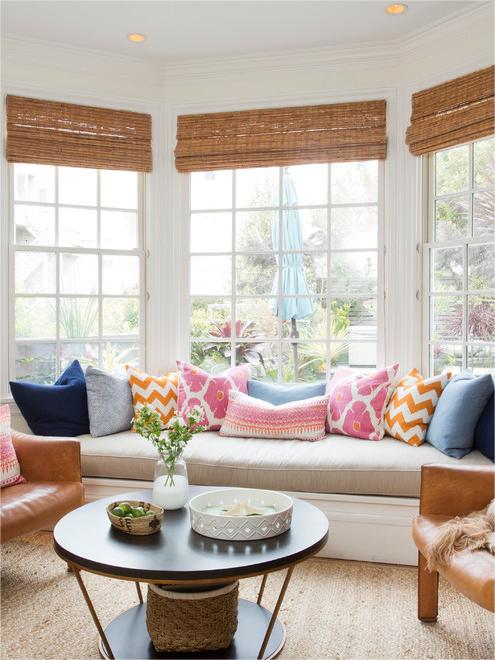
Light Control and Privacy Features
Adjustable Slats: Blinds with adjustable slats, such as Venetian blinds, provide precise control over the amount of sunlight entering the room. Tilt the slats to find the perfect balance between natural light and privacy.
Opaque or Sheer Fabrics: Roller blinds often come in various fabrics, including opaque and sheer options. Opaque fabrics offer privacy, while sheer fabrics allow diffused light to enter, maintaining a sense of openness.
Top-Down Bottom-Up Mechanism: Some blinds, like Roman blinds, may feature a top-down, bottom-up mechanism. This allows you to lower the top or raise the bottom of the blind, giving you control over light and privacy.
Design Flexibility and Material Options
Wooden Blinds: Whether real or faux, Wooden blinds add warmth and natural beauty to bay windows. They are available in various finishes to match different design aesthetics.
Aluminum Blinds: Aluminum blinds are lightweight and durable, suitable for modern and minimalist interiors. They come in various colors and are moisture-resistant, making them ideal for bay windows.
Fabric Choices: Blinds with fabric panels, such as Roman blinds, offer a wide range of choices in terms of colors, patterns, and textures. This flexibility allows you to customize the blinds to suit your interior design.

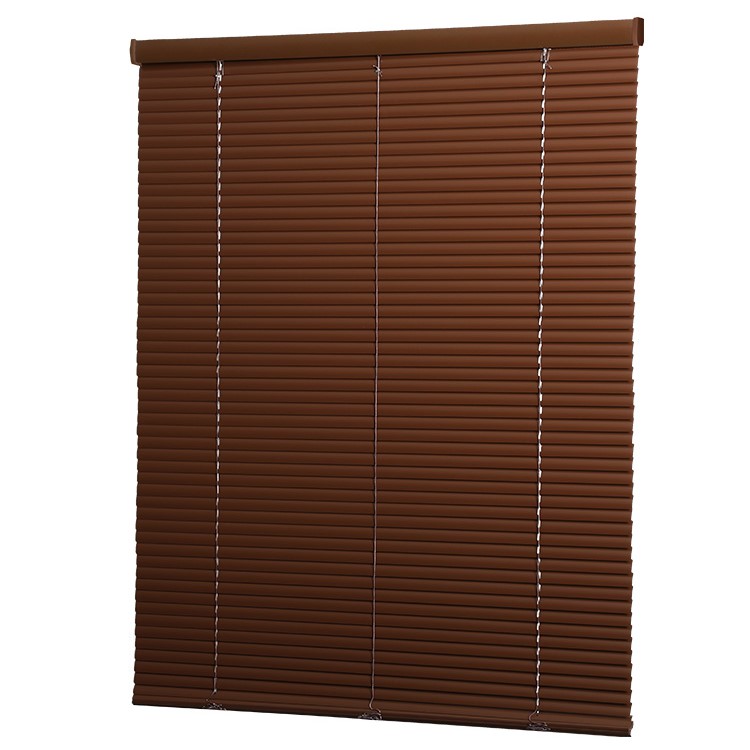

Curtains for Bay Windows
Curtains add a touch of luxury and softness to bay windows, creating an inviting and cozy atmosphere. In this section, we’ll explore the various curtain styles and fabrics available for bay windows, the softness and elegance they bring to interior design, and the limitations and considerations of choosing curtains.
Various Curtain Styles and Fabrics
Panel Curtains: Single or multiple fabric panels that can be drawn open or closed, offering simplicity and versatility in design.
Café Curtains: Partial-length curtains covering the window’s lower portion, allowing ample light while preserving privacy.
Sheer Curtains: Lightweight and translucent, sheer curtains add an airy and ethereal quality, perfect for diffusing light.
Floor-Length Curtains: Elegant floor-length curtains, pooling gracefully on the floor, create a dramatic and formal look suitable for larger bay windows.
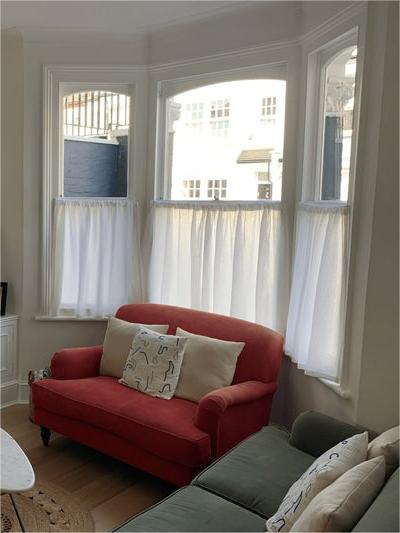

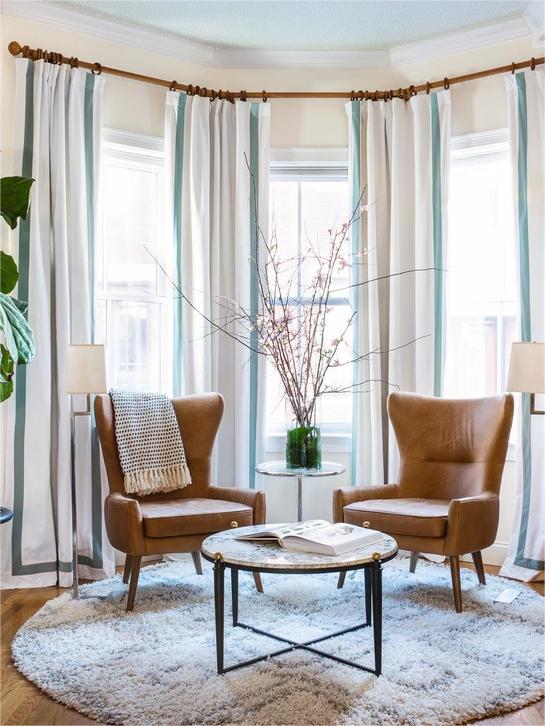

Patterned Fabrics: Curtains come in various fabrics, including solid colors, patterns, and textures. Choosing the right fabric can significantly impact the overall aesthetic.
Softness and Elegance in Interior Design
Warmth and Softness: Curtains introduce softness and warmth to the room, creating a comfortable and inviting atmosphere around bay windows.
Elegance and Drama: Floor-length curtains, especially those with rich textures or patterns, contribute to an elegant and dramatic design, becoming a focal point in the room.
Layering Effect: Combining sheer curtains with heavier drapes allows for a layered effect, providing privacy and flexibility in controlling light.
Customization with Accessories: Curtains offer customization through accessories such as tiebacks, valances, or decorative rods, allowing you to personalize the overall look.
Limitations and Considerations
Space Constraints: Curtains require sufficient wall space on either side of the bay window for proper installation. Limited space may impact the choice of curtain styles.
Maintenance and Cleaning: Heavier curtains may accumulate dust and require regular maintenance. Consider the practicality of the chosen fabric in terms of cleaning and upkeep.
Light Control: While curtains provide softness, they may offer a different level of precise light control than blinds or shutters. Consider your preferences for a soft ambiance in the room.
Potential Blocking of Views: Depending on the chosen style and length, curtains may partially or fully block the view from bay windows. This factor should be considered, especially if the view is significant.
Making the Decision: Plantation Shutters, Blinds, or Curtains?
Choosing between plantation shutters, blinds, and curtains involves carefully evaluating the pros and cons, understanding how each option meets specific needs, and personalizing the decision based on your preferences and the unique characteristics of your bay windows.

Pros and Cons Comparison
Plantation Shutters:
- Pros:
- Timeless elegance and durability.
- Precise control over light and privacy.
- Easy maintenance and long-term investment.
- Cons:
- Higher upfront cost compared to some blinds and curtains.
Blinds:
- Pros:
- Versatile styles and materials.
- Adjustable slats for light control.
- Varied pricing to fit different budgets.
- Cons:
- Some materials may require more maintenance.
- Limited insulation compared to shutters.
Curtains:
- Pros:
- Soft and luxurious aesthetic.
- Budget-friendly options.
- Versatility in fabric choices.
- Cons:
- Requires more maintenance, especially heavier fabrics.
- Limited light control compared to shutters and blinds.
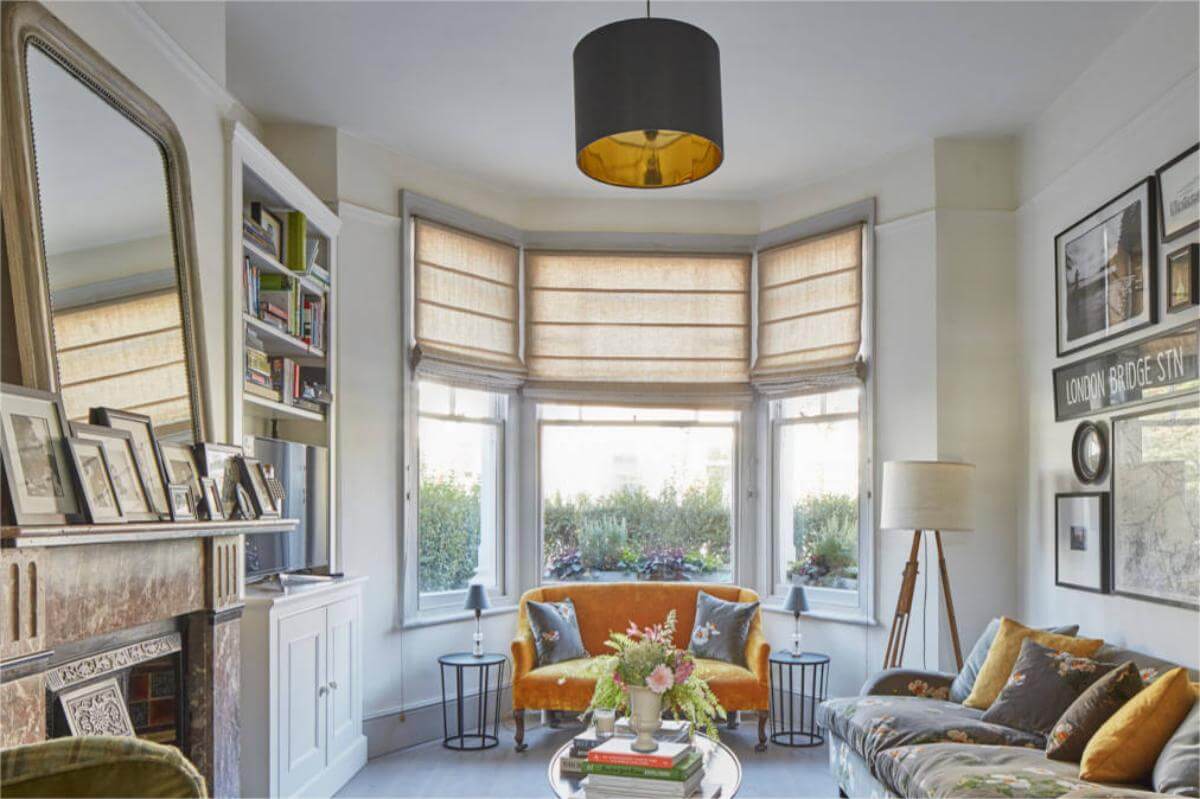
How Each Option Meets Specific Needs
Light Control:
- Plantation Shutters: Precise control with adjustable louvers.
- Blinds: Versatile light control with adjustable slats.
- Curtains: Softened light, especially with sheer fabrics.
Privacy:
- Plantation Shutters: Excellent privacy control.
- Blinds: Effective privacy, especially with opaque materials.
- Curtains: Privacy varies with fabric choice.
Aesthetic Appeal:
- Plantation Shutters: Timeless elegance and customization.
- Blinds: Modern and versatile, with varied styles.
- Curtains: Soft and luxurious, customizable with fabrics.
Maintenance:
- Plantation Shutters: Easy maintenance with regular dusting.
- Blinds: Maintenance varies by material.
- Curtains: Requires regular cleaning, especially heavier fabrics.
Budget Considerations:
- Plantation Shutters: Higher upfront cost, long-term investment.
- Blinds: Varied pricing, accommodating different budgets.
- Curtains: Budget-friendly options; costs may vary.

Personalizing the Decision Based on Preferences
Consider Your Design Style:
- Traditional Elegance: Plantation shutters.
- Modern and Versatile: Blinds.
- Soft and Luxurious: Curtains.
Evaluate Maintenance Tolerance:
- Low Maintenance: Plantation shutters.
- Varied Maintenance: Blinds.
- Regular Maintenance: Curtains.
Prioritize Light and Privacy:
- Precise Control: Plantation shutters.
- Versatile Control: Blinds.
- Softened Light: Curtains.
Budgetary Considerations:
- Long-Term Investment: Plantation shutters.
- Varied Budgets: Blinds.
- Budget-Friendly: Curtains.
Ultimately, the decision rests on your preferences, lifestyle, and the specific needs of your bay windows. Whether you prioritize timeless elegance, modern versatility, or soft luxury, each option offers unique benefits. Consider the factors that matter most to you, and choose the window covering that transforms your bay windows into a focal point of beauty and functionality.

